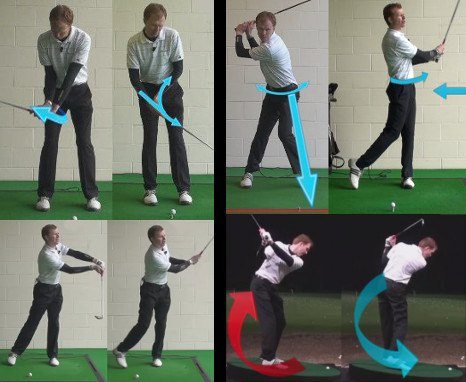One of the most frustrating aspects of hitting a shank is the unpredictable nature of the shot. While some people will be plagued with persistent shanks, others can have them pop up seemingly out of nowhere. You can be going about your round, playing well, only to have a shank show up at the worst possible time. Of course, after you hit one shank, you will play the rest of the round in fear of hitting another. That fear can make your swing tentative, and you may have trouble regaining the form you had before the shank. This is a swing problem that is as much mental as it is physical, and just one or two shanks can throw you off of your game for many rounds to come.
As with anything else in golf, you need to take a close look at your technique when trying to fix this swing problem. Although the shanks can seem unpredictable, it is usually possible to find a specific cause when you break down the mechanics of your swing. This process can take some time, but it will be worth it when you are left with a swing that allows you to play every round shank-free.

This is the topic that no golfer really wants to discuss. There are few subjects on the course which are as taboo as the shanks – golfers simply don’t want to talk about it. However, in this article, that’s exactly what we are going to do. Rather than running from the topic, let’s deal with it head on and figure out why you are hitting shanks and what you can do to move your swing in the right direction.
One of the issues you are going to have to get over is the emotional baggage that can come along with hitting shanked shots. When you start to hit some shanks, you’ll get increasingly frustrated with the issue and may not even feel like playing at all. If you are going to get past this problem once and for all, you need to do your best to set emotion to the side and just focus on the changes necessary to make progress. Later in the article, we’ll take a closer look at the emotional side of this matter, as it is going to play a big role in your improvement.
All of the content below is based on a right-handed golfer. If you happen to play left-handed, please take a moment to reverse the directions as necessary.
— What is a Shank?
There is actually a fair amount of confusion regarding what a shank is, and it’s important to understand this point so you can go about correcting your shanks in the right way. And, before you can accurately explain how a shank works, we need to talk about the design of your golf clubs and the various components that make up your clubs. Specifically, we will be talking about irons, since those are the clubs prone to shanks. Let’s talk about three key elements of your irons that are going to play a role in this story.
| GOLF FIXES BY PGA PROS |
|---|
| Swing Upright to Cure the Shanks | Video | Article |
| The Shanks Causes And Cures In The Golf Swing | Video | Article |
| Swing Upright to Cure and Fix the Shanks | Video | Article |
| What Are Bunker Shanks In Golf And The Problem They Cause | Video | Article |
| Cure the Shanks to Start Enjoying Golf Once Again | Video | Article |
| Cure Your Golf Bunker Shot Shanks | Video | Article |
| Golf Shanks In The Short Game | Video | Article |
| Shanks Cure How Senior Golfers can Fix this Golf Problem | Video | Article |
| Out Side Swing Path Causes Golf Shank | Video | Article |
| Causes Of Hitting A Shank In Golf When Chipping | Video | Article |
| What Is The Cause Of The Shank And How Women Golfers Can Cure This Problem | Video | Article |
| A Deeper Fix For A Golf Shank | Video | Article |
| A Few Quick Fixes For The Golf Shank | Video | Article |
| Failure To Release The Golf Club Causes Of The Shank | Video | Article |
| Understanding The Golf Shank | Video | Article |
| How To Solve A Golf Shank | Video | Article |
| What Are The Causes Of The Shank In Golf | Video | Article |
| How To Solve A Shank, Golf | Video | Article |
| Lack Of Confidence Causes The Golf Shank | Video | Article |
| LESSONS |
|---|
| Help Stop my Shanks – Golf Tip | Video | Article |
| Top 4 Tips On The Best Ways To Fix Shanks | Video | Article |
| Practicing To Stop Shanks When Golf Chipping | Video | Article |
| Key Points To Avoid Golf Shanks | Video | Article |
| Release the Club Fully to Remain Shank-Free | Video | Article |
| Correcting Path To Avoid Golf Bunker Shank Shots | Video | Article |
| Shank Fault A to Z Lesson | Video | Article |
| How To Slide The Club Underneath The Ball To Avoid Bunker Shank Shots | Video | Article |
| Mental Approach To Stop A Shank In Golf When Chipping | Video | Article |
| Understanding Where Golf Bunker Shank Shots Come From | Video | Article |
| Fix my Shank Swing Problem Ball Hits on the Heel | Video | Article |
| Understanding the Shank | Video | Article |
| What Is The Shank In Golf | Video | Article |
| Other Issues To Consider With The Golf Shank | Video | Article |
| PRACTICE DRILLS |
|---|
| Blue Tac Stops The Shanks | Video | Article |
| Drills To Avoid The Golf Shanks | Video | Article |
| Shank Golf Shot Problem Drill 1 | Video | Article |
| Shank Golf Shot Problem Drill 2: Swing and miss on inside | Video | Article |
| Shank Golf Shot Problem Drill 3: Two balls hit inner ball | Video | Article |
| Shank Golf Shot Problem Drill 4: Face tape | Video | Article |
| Shank Golf Shot Problem Drill 5: Drop club inside at top | Video | Article |
| Shank Golf Shot Problem Drill 6: Weight onto heals in follow through | Video | Article |
| GOLF QUESTIONS |
|---|
| What Are The Shanks And How Can I Get Rid Of Them? | Video | Article |
| How Can I Stop the Shanks? | Video | Article |
| Why Do I Hit More Shanks When I Am Playing Golf Bunker Shots | Video | Article |
| Right Hand Golf Tip: How to Cure the Shanks | Video | Article |
| Shank Golf, What Are The Shanks And How Can I Get Rid Of Them | Video | Article |
| Shank Golf, What Are The Shanks And How Can I Get Rid Of Them | Video | Article |
| Golf Shank, What And Why Causes Shanking My Irons | Video | Article |
| Whats the best quick fix for a shank? | Video | Article |
| Why Do I Shank My Golf Chip Shots Under Pressure? | Video | Article |

- Toe. The toe of the club head is the end that is farthest away from the shaft. In other words, the far end of the club head is the toe. When someone says they hit a shot out toward the toe of the club, that means they made contact with the ball on the far side of the sweet spot.
- Heel. You can probably guess where the heel is based on our discussion of the toe. The heel is the side of the club head in toward the shaft, nearer to your body than the sweet spot. Just as you can miss out toward the toe, you can also miss in toward the heel.
- Hosel. The hosel is the spot where the shaft is actually connected to the club head. There is an angle at this point that moves to the right as you look down from address – and that angle is more dramatic when you have clubs with a greater offset (which is a topic for another article). While all clubs have a hosel, because all clubs need a way to connect the shaft to the clubhead, it is more prominent as a design feature on irons than woods or putters.
So, with those definitions out of the way, we can get back to the topic at hand – the shank. What happens when you shank the ball? Simply put, you have made contact with the hosel of the club, rather than the actual club face. The ball shoots off to the right because you hit the hosel and the angle of that part of the club will send the ball immediately to the right in most cases. When you hit a shank, you will feel the poor contact come all the way up through the shaft of the club and into your hands. That is because you haven’t hit the ball on the intended striking area of the club, and the feedback you get from the shot tells you everything you need to know.
One of the reasons for confusion among some players is the fact that the ball has gone to the right, which makes golfers think they have hit the toe. After all, the toe is on that side of the club head, so wouldn’t it stand to reason that you hit that side of the club at impact? While that does make some sense, and it is possible to hit the ball off the end of the toe, a true shank comes off the hosel. So, rather than trying to move the point of contact from the toe back in toward the sweet spot, you need to move it from the hosel and out further to the middle of the club.
It’s important to get this explanation clear in your head before moving on because you can actually make your shank problem worse if you are trying to solve it in the wrong way. Basically, if you think you are hitting the ball on the toe already, so you try to move the club farther from you through impact, you’ll only be making it more likely that you are going to hit a shank. Knowing that your shanks are actually coming off the hosel, you can go about making the right corrections – and hopefully you’ll be able to make them sooner rather than later.
— Causes of the Shanks
With our definitions out of the way, let’s move on to what you really care about – what is going wrong in your swing to cause you to hit shanks in the first place. Obviously, something is not quite right with your technique, or this wouldn’t be happening. You are delivering the hosel to the golf ball rather than the middle of the club face, so that issue needs to be corrected if you are going to get back on track.
Of course, as you might expect, there are plenty of different issues which can lead to the shanks. It’s not going to be as easy as telling you to stop doing one certain thing in your swing, because there are plenty of things you could be doing wrong. The list below highlights some of the potential swing issues that could be contributing to your shank problem.

- Active hands in the takeaway. Unfortunately, it’s possible for things to go wrong from the very start of the swing. As soon as the club starts moving, you can put yourself in a position that is going to be more likely to produce a shank. That is going to be the case when you use your hands and wrists to actively during the takeaway phase. If you ‘roll’ your hands away from the target and open up the club head immediately, you’ll basically be exposing the hosel to the ball from the start. That means, if you don’t make some kind of correction or adjustment before impact arrives, a shank is a likely outcome. Rather than using your hands so actively, a proper takeaway involves keeping your hands quiet while your shoulders do the work. Let your shoulders turn your upper body away from the target without much involvement at all from your hands and wrists. Those smaller muscles should only get involved later to set the club in position after the backswing is well underway. Making a change to this part of your technique an be a challenge to say the least, but it can lead you to dramatically improved play once you do figure it out.
- Inconsistent balance. Moving all around during the golf swing is another way to get into trouble with the shanks. Ideally, your body weight should follow a very predictable and balanced path throughout the swing. At the start, you should have great balance with your weight evenly distributed between your feet. As the backswing develops, your center of gravity shouldn’t move much, as you turn away from the target by rotating rather than sliding. Then, in the downswing, you’ll start to move your weight toward the target somewhat, but only as a response to your aggressive body rotation. All in all, your body weight positioning should be pretty stable and steady throughout the swing. If that is not the case, there’s a chance you’ll open yourself up for a shank. Specifically, what you need to watch out for is moving away from the ball on the way back and toward the ball on the way down. This is going to crowd your downswing and it is going to bring the hosel closer to the ball at impact. Pay attention to your takeaway if you think you are making this mistake. Stay nicely balanced early in the swing without drifting in any direction. If you can get through the start of the swing without balance issues, it’s likely that you’ll be able to stay on track through impact.
- Stopping the turn. This is a big one, and as we will discuss later in the article, it is an issue that can grow worse once you start to fear the shanks on the course. What happens here is that you give up on the rotation of your body partway through the downswing. When you stop turning, or you slow down your turn, you will run out of space to swing through the hitting area. In other words, your lower body and torso will still be in the way, so your hands will need to ‘go around’ in order to find contact. That is again going to force the club out too far away from your body, and you’ll run the risk of hitting a shank. To steer clear of this problem, do your best to keep your lower body rotation going all the way through impact. Not only will this help you avoid shanks, but it can also produce more power in your swing. Good rotation is the foundation of a quality golf swing, so make this point one of your keys as you practice.
- The lie of the ball. This one is not an issue with your swing technique, per se, but rather the situation you find yourself in on the course. When you have a ‘hanging lie’ – one where the ball is below your feet – it’s a little bit easier to run into problems with the shanks than it would be otherwise. The problem here comes back to balance. When standing on a lie where the ball is down below the level of your feet, you’ll naturally be leaning forward a little bit at address. Then, when the swing starts, you might be inclined to lean even a little more out over the ball. This is going to get you closer to the ball than you want to be by the time impact arrives, and the shank will suddenly be a possibility. It’s important on these kinds of uneven lies to add a little extra knee flex to improve your balance and make it easier to stay centered.
There are plenty of ways in which the golf swing can go wrong. Some of those issues can lead to shanks, so it’s important to work on ironing out as many of the problems listed above as possible. No one has a perfect golf swing – not even the professionals – so don’t feel bad if you can’t quite work out everything. As long as you are making progress and improving your technique overall, you should be able to move your scores in the right direction.
— The Mental Component
No article about the shanks in golf would be complete without a discussion of the mental side of this issue. We quickly mentioned this earlier, but it is worthy of an expanded section because of the importance this piece of the puzzle will play. If you can’t get your mind right, you stand very little chance of moving on with your game in a positive way.
The shanks are a mental challenge for a variety of reasons. First, they are embarrassing. If you hit a shank in front of a group of your friends – or even strangers – you are likely to feel embarrassed about the shot you have just hit. That’s not such a big deal, except for the fact that you will remember that negative emotion and you won’t want to repeat it. So, when hitting your next shot, you may be a little more nervous and you might struggle to focus on the task at hand. Your mind will still be on the previous shot, wondering what went wrong.
As mentioned in the previous section, one of the swing issues that can lead to a shank is a poor downswing turn. Unfortunately, you are likely to struggle with that issue even more once it has popped up in your game. This is because making the downswing turn is an aggressive, confident move – and you probably won’t be feeling very aggressive or confident after you have hit a couple of shanks. Instead, you’ll be feeling nervous and timid, which is a recipe for making your turn even worse.
In the end, getting over the mental hump is all about attitude. You have to have the right attitude that you are going to beat this issue, and you aren’t going to let it take over your game. That is easy for us to say, but it’s challenging to do in real life. The tips below will hopefully help you get over this mental hurdle.

- Hit plenty of balls. There is nothing quite like ‘range therapy’ for working out the issues in your game. On the range, you don’t have to worry much about the outcome of any specific shot, because there is always another ball waiting to be hit. The embarrassment factor is also taken out of the equation, as it’s likely that no one will be watching or paying attention. So, during your practice sessions, you are free to simply make great swings and work on fine tuning your technique. The more shots you can hit on the range without running into shank problems, the better you will feel about things on the course.
- Accept the challenge. Some golfers have trouble accepting the reality that this is a hard game. Golf has a reputation as one of the most difficult games in the world, and for good reason. The challenge of the game is part of the appeal, but you need to accept it and understand that there will be struggles along the way. Don’t give up just because you are having trouble with the shanks right now – just keep working and look forward to the accomplishment of putting this issue behind you.
- Keep it simple. It’s easy to fall into the trap of overcomplicating this game. However, the best swings tend to be those that keep things simple and execute the basics properly. During those range sessions we talked about above, spend plenty of time working on the fundamentals and trust that everything else will come together.
One of the best assets you can have working for you in this game is a strong mind. The physical challenges of hitting good shots are many, so you can fight back against those challenges by using your mind to your advantage. Don’t fall into the trap of letting negative thoughts take over your game. By thinking positively, you’ll not only make more progress, but you’ll also have more fun along the way.
— Shanks in the Short Game
The shanks are a golf issue that is most-commonly associated with the full swing. However, it’s possible to shank short shots, and this issue can be just as frustrating for the player. If you are dealing with this problem, your scores are sure to suffer.

First of all, shanks are not something that you should have a problem with when putting. There is no hosel exposed to the ball in most putter designs, and the small swing of the putter makes it hard to miss the sweet spot by very far. Sure, you can miss-hit putts – and everyone does occasionally – but those miss-hits are unlikely to be shanks.
For shanks, it’s more likely to be chip shots that give you trouble. Often, it is when the player is trying to swing across the ball dramatically from outside-in that a shank will appeal. This is because the hosel is naturally going to pass close to the ball with that kind of swing. Even a small error can lead to a shank when you try to swing across the ball. That technique can be effective for hitting the ball high, but move away from it for now if it is leading to shanks. Instead, try to swing straight down the line and give yourself the best possible chance to find the sweet spot.
Looking up early is another short game problem that can lead to a shank. If you are too anxious to see where the ball is going to go, you might pick your head up early to take a peek. That isn’t going to help anything, of course, and it will put you at a greater risk of a shank. To kick this habit out of your game, work on watching a specific spot on the ball until you have struck the ball and sent it on the way. Don’t just look at the ball itself – look at something specific, such as the number, a logo, a mark you drew, or something else. Whatever it is, keep your eyes locked on that spot until the club swings through impact. If you practice that technique consistently, it will become natural and you won’t be tempted to look up prematurely anymore.
Plain and simple, the shanks are no fun. It’s hard to feel like heading out to the golf course when you are afraid of hitting shanks throughout your round. Fortunately, this is something you can conquer, as long as you are willing to do a bit of work along the way. We hope this article will help you take the first step toward reducing the number of shanks you hit in your game.






